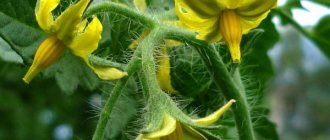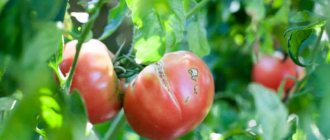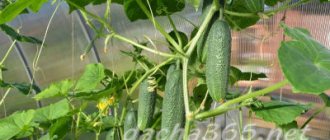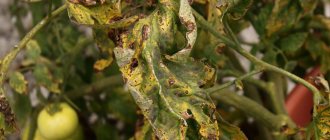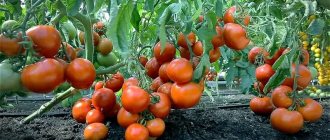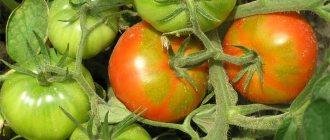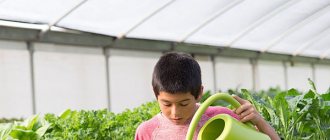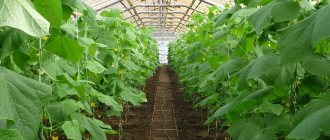Climatic conditions in the greenhouse
Tomatoes are a heat-loving garden crop.
If the temperature is too low, the tomatoes will not bear fruit, grow poorly, bloom poorly, or die altogether. But high temperatures are also considered unfavorable for plantings in a greenhouse; the fruits grow too small, and the plant stems dry out quickly. If the air temperature drops to 14 degrees, pollen does not ripen. When watering with cold water, the ovaries also do not ripen. If cold weather continues for too long a period of time, tomatoes in the greenhouse and in the open ground do not set, and the inflorescences not covered with pollen dry out and simply fall off.
But extreme heat is also negative for fruits and ovaries. If temperatures remain at 35 degrees even for several days, pollen is not pollinated.
Preventive measures
As a preventative measure, it is necessary to follow tomato farming techniques starting from scratch:
- First of all, you need to choose the right seeds from a reliable manufacturer. Your own seed material must be pickled in a solution of potassium permanganate or hydrogen peroxide so that the tomatoes do not get sick in the future.
- Before planting seedlings, experienced gardeners spill boiling water on the soil or treat it with copper preparations for high-quality disinfection.
- At all stages of seedling development, it is necessary to follow the agricultural practices of the crop so that the seedlings grow healthy and strong. Thin, elongated seedlings are reluctant to bloom, as they simply do not have enough strength to do so.
- If, due to improper maintenance conditions or poor quality of seeds, tomatoes become ill with a bacterial, fungal, or viral disease, experienced gardeners advise not to waste time treating the affected specimens. Such tomatoes are thrown away as soon as possible so that they do not infect other bushes. For the remaining plants, it is recommended to carry out preventive treatment with fungicides or disinfectants.
- If you suspect excess nitrogen in the soil, it is enough to sprinkle the soil with sawdust - they can absorb some of the nitrogen compounds.
- For seedlings planted in a greenhouse, it is necessary to create a suitable temperature regime. If the temperature is too low, you can install heating devices.
- In hot weather, the building must be ventilated daily. To protect from the scorching sun, a chalk composition is applied to the walls of the greenhouse or the structure is covered with a special mesh.
- When watering in hot weather, the paths between the beds are also moistened. Evaporation of water will reduce the temperature in the greenhouse.
- To prevent the bushes from shading each other as they grow, they are planted according to the correct pattern, taking into account the variety. A distance of 30-35 cm is left between determinant bushes, the interval between tall tomatoes should be at least 45-50 cm.
- Stepchildren need to be removed regularly so that the bushes have access to light on all sides.
- After watering, the soil is regularly loosened to ensure a flow of oxygen to the roots. This same technique allows the soil to retain moisture longer.
- To grow on the balcony, tomatoes are planted in 8-10 liter pots or buckets. At home, in winter and spring, the crop will require additional illumination with fluorescent lamps.
Why tomatoes don't bloom: video
Tomato is one of the favorite vegetables on our table. Once upon a time, the crop was grown as a decorative decoration for the garden, then tomatoes appeared on the menu of rich nobles. Now these vegetables are available to everyone without exception, and only the lazy do not grow them on their plot. By following the agricultural practices of the crop, you can certainly count on a rich harvest and provide yourself with plenty of vitamins.
Useful material
In some cases, a lack or excess of certain substances can lead to the cessation of flowering, and in rare cases, the death of plants.
- Excess nitrogen fertilizers lead to deformation of flowers. This prevents beneficial insects from pollinating the flowers. Occurs when tomatoes are overfed with manure.
- A lack of potassium or phosphorus leads to drying out of parts of tomato bushes, including flowers. The flowers fall off without being pollinated.
Solution
It is necessary to regularly check plants for signs of lack or excess of fertilizers in the soil, and immediately adjust feeding. It is necessary to feed tomatoes with nitrogen-based fertilizers before flowering, and at the moment of flowering - only in case of deficiency.
Stepsoning
By July, the tomato bushes are already formed; one or several stems are left on them, depending on the plant variety. But this month new stepsons appear from the sinuses, which need to be removed, leaving small stumps 1–2 cm long.
This procedure will help in the future to avoid repeated flowering, as well as the formation of new shoots that reduce yield. Pruning requires a garden tool treated with a solution of potassium permanganate. Under no circumstances should you pluck shoots with your hands.
Fertilizers applied
Improper application of fertilizers can also cause a lack of flowers. If the seedlings have outgrown and are characterized by vigorous development of tops, but there are no flowers, the amount of nitrogen fertilizer applied has exceeded the norm. It is the presence of this element in the soil that stimulates the development of green mass in the plant. Excessive application of it negatively affects the development of flowers or completely eliminates it.
And vice versa. A lack of minerals (phosphorus and magnesium) leads to poor development of bushes and tomatoes bloom poorly in open ground. It is necessary to remember this; fertilizing the plant should be balanced and carried out no more than four times per season.
Features of care
Growing tomatoes at home at the initial stage of their life cycle is largely similar. Regardless of whether it is seedlings for further planting in open ground or a permanent pet, all tomatoes are characterized by “childhood” diseases. Failure to comply with the required care conditions can ruin the entire harvest, destroying the ripening crop.
This article will be devoted to the peculiarities of caring for tomatoes, which one often encounters when growing on a windowsill or on a balcony plantation.
The difficulties that arise for the gardener from the moment thin, delicate shoots appear, accompany him throughout the entire period of growth and maturation.
These difficulties are associated with a number of factors - the lack of space for the full development of the root system, insufficient lighting in the winter months, dry air in apartments during the heating season and a host of diseases introduced from outside, to which tomatoes are extremely susceptible.
Reasons for the absence of ovaries
Tomatoes, despite all their possible capriciousness, are very responsive to good care. And if all conditions are created for them, you will definitely have a harvest. At the same time, even if you are faced with some problem, you should not give up. It is necessary to first identify the cause, and then begin to act immediately.
Your tomatoes are growing in a greenhouse, gaining color, and you see that there is no ovary. This means that there is some kind of violation in the agricultural technology of the crop and it must be found. Below we will give possible reasons why tomatoes do not form ovaries, as well as options on how to fix this.
Temperature
Tomatoes love warmth and moderate humidity, so we immediately check what temperature conditions are maintained in your greenhouse.
Optimal temperatures are 20-25°C. If the greenhouse is too hot, the tomato pollen will be sterile; if the temperature drops below +15°C, the pollen will not ripen.
What to do:
- When the shelter is very hot and hot, be sure to ventilate the greenhouse. Tomatoes love drafts; in such conditions they grow better and form good ovaries.
- If it is cool at night, then you should insulate the shelter with improvised means.
ADVICE! It is good to place tanks or a barrel of water in the greenhouse with the tomatoes. During the day, the water will heat up well, and at night it will give off heat, and the plants will not feel the temperature change.
Humidity level
Everyone knows that tomatoes do not like high humidity, but at the same time, too dry air is contraindicated for them. In the first case, moisture will provoke the development of various diseases, and pollen will stick together. In dry air, pollen will not germinate, which leads to the ovaries falling off and becoming sterile.
What to do:
- Regular, abundant watering is mandatory. In this case, water should not get on the leaves, ovaries and fruits of tomatoes; water strictly at the root.
- The irrigation regime is set based on weather conditions. Tomatoes love abundant but infrequent watering.
Fertilizer application
When growing any variety of tomatoes, fertilizing is mandatory, but the main thing here is to maintain a balance. It is necessary to control the condition of plants, to prevent an excess of some elements and a lack of others in their nutrition.
So, sometimes inexperienced gardeners can overdo it with adding organic matter (manure), which leads to oversaturation with nitrogen. Under these conditions, tomatoes grow actively, gain green mass, but there are no or very few ovaries and the plants do not bear fruit.
Tomatoes need elements such as phosphorus and potassium, so they must be included in the fertilizer.
What to do:
- Apply fertilizers strictly according to the scheme, avoiding violation of proportions.
- Use superphosphate or nitroammophoska as fertilizers, which contain the set of microelements necessary for tomatoes.
Pollination
The fruit of a tomato is formed only in case of pollination, and this requires either insects or a small breeze. Also, gardeners often carry out artificial pollination, thereby starting the process of ovary formation.
What to do:
- Be sure to ventilate the greenhouse by opening doors and vents.
- Attract insects to the shelter. To do this, you can plant a couple of honey plants next to the tomatoes. Sometimes gardeners simply bring a few flowering plants in pots into the greenhouse.
ADVICE! Planting tagetes (marigolds) or basil in a greenhouse will not only attract bees, but will also help improve the taste of tomato fruits.
If natural pollination does not occur, help the tomatoes manually.
- In the morning, gently shake the plants so that the pollen wakes up. When using trellises, you can lightly tap the ropes or wires.
- Pollination can also be carried out by transferring pollen from the ovaries using a regular brush.
ADVICE! After the pollination procedure, it is necessary to lightly water the plants to increase the level of air humidity in the shelter.
Lighting
Due to poor or insufficient lighting, tomatoes do not form ovaries and flowers fall off.
What to do:
- Use high-quality materials to make a greenhouse with optimal light transmittance for tomatoes.
- Form plants in a timely and correct manner, remove shoots and lower leaves so that flowers and fruits have access to sunlight.
Improper watering
It is not allowed to water plants with cold water. You only need warm, well-settled water, and watering must be done at the root.
Secrets of experienced gardeners
The problem with pollination of tomatoes is typical for greenhouses. Often the natural process may not be possible due to the lack of wind and pollinating insects. In these cases, you can often ventilate the room so that a draft carries pollen and insects have free access to the plants. Some vegetable growers help the plants by gently shaking them so that the pollen falls off on its own.
You can help the plant bloom with the help of processing. For these purposes, you can use double superphosphate and potassium sulfate. Add 15 grams to a bucket of water. components. Manganese solution and boric acid will also help the proper formation of ovaries.
If pollination occurred artificially, you need to increase the humidity immediately after the procedure. You can water the plants or spray them with a spray bottle. After a few hours, you need to open the greenhouse for ventilation.
Some gardeners plant several varieties of tomato, differing in resistance to disease and climate. This measure is a safety net in case one of the varieties produces an empty ovary.
If measures are taken and the problem is not solved, you need to remove all barren flowers from the plant. This method will force the seedlings to devote all their resources to the formation of new ovaries.
Why tomatoes don't set: main reasons
If the tomatoes have grown almost to the ceiling, bloomed together, but there is no ovary, evaluate the microclimate created in the greenhouse. During budding, flowering and fruit formation, this crop is very demanding on growing conditions.
Temperature in the greenhouse
In greenhouse conditions, it can be difficult to keep track of the air warming up. On sunny days, the space limited by film or glass can warm up to +40º C and above. At night, without solar heating, the temperature often drops to +12…+15º C.
Such temperature discrepancies often lead to delayed development or absence of ovaries:
- If the greenhouse is extremely hot, the tomatoes will not be pollinated. In the heat of +30º C, the fertilizing properties of pollen are reduced; at +35º C, tomatoes become sterile. Heat around +40º C guarantees the release of flowers.
- If it is colder in the greenhouse during the day +15º, and at night +13º C, then all biological processes slow down. As a result, pollen maturation stops and the development of the entire plant is delayed.
- Insufficient difference between temperatures after sunset and during the day is also detrimental to the crop. If at night it is hotter than +23-25º C, then the biological rhythm is disrupted and the tomatoes do not “rest”. With round-the-clock heat, they spend a lot of energy to support their vital functions. Due to this, the bush weakens, it does not have the strength to set fruit.
- If the temperature difference is too great, condensation will collect on the greenhouse glass, causing an unnecessary increase in humidity.
Humidity control
When the flowers bloom and the pollination period begins, tomatoes do not need too humid air. In addition to disturbances in the maturation and germination of pollen, the greenhouse effect provokes the development of fungal diseases that weaken the bush.
To obtain accurate indicators, hygrometers are installed in the greenhouse. If this is not possible, then humidity can be determined using the traditional method. To do this, squeeze the soil in your hand in which the tomatoes grow. If it rolls well into a ball and breaks easily when pressed, then the humidity is normal.
To make the air more humid, it is enough to spill water between the rows and paths. Reducing humidity in regions with a damp climate is not so easy. To do this, you need to reduce evaporation: mulch the soil, ventilate, water the tomatoes drip through a buried bottle without a bottom.
Soil moisture
Tomatoes are drought-resistant plants, so you can’t pamper them with daily watering. With a constant excess of moisture and nutrition, only the green part grows, and the roots have no incentive to develop.
When flowering reaches its peak, the lack of moisture for fruit set begins to affect. Then, instead of forming ovaries, the tomatoes begin to grow a root system, while the growth of the rest stops.
There is no need to water tomatoes in a greenhouse often - it is enough to do it 1-2 times a week in the early morning to avoid condensation. Curled leaves and drooping tops serve as a signal for urgent watering.
Pollination
If ground tomatoes are pollinated naturally with the help of insects and wind, then during greenhouse cultivation this issue cannot be left to chance.
During sunny, warm weather, be sure to open greenhouse windows for ventilation, this will allow air flow and beneficial insects to enter to transfer pollen. If the climate does not allow this, install a ventilation system or pollinate by hand.
There are several successful methods of artificial pollination:
- Shaking. Lightly shake the tomato bush while weeding or watering - this movement is enough to release the pollen.
- Artificial wind. For large quantities of tomatoes, it is convenient to use a portable fan.
- Pollination by hand. In order to “work as a bee” you need a soft brush, which you need to easily walk through the flowering bushes. If you like to experiment, you can use this method to cross-pollinate crops of different varieties.
To ensure that as many pollinating insects as possible rush into the greenhouse during ventilation, plant honey-bearing flowers next to the tomatoes.
Other reasons for the absence of ovary
Equating the process of growing in open ground and in greenhouse conditions is a common mistake of novice tomato growers.
Pollen does not reach the pistil
In open ground, insects improve pollination of tomato flowers.
The process of growing tomatoes in open ground has its own difficulties, but it is not without its charms.
The wind performs a similar function. Under the influence of air masses, pollen can spread to other parts of the plant, in particular onto the pistil.
In the greenhouse, the number of insects, if present, is in minimal quantities. As a rule, they do not take part in the pollination process.
Self pollination
There are no bees or wind in the greenhouse, so you have to pollinate the flowers manually using a brush.
Ventilation also does not guarantee the spread of pollen. Thus, pollination in greenhouse conditions does not occur on its own. Gardeners have to manually pollinate plants or resort to special solutions.
An effective measure is also to treat plants with a solution of boric acid (10 g per 10 liters). You can find out whether pollination is occurring by observing flowers. Fertilized flowers have petals curled back.
The feeding regime is broken
Tomatoes overfed with fertilizers are distinguished by large, juicy leaves and rare weak flowers.
Many gardeners, considering that their tomatoes will grow in a greenhouse and not in open ground, strive to feed the plants as often and as much as possible.
The leaves of such a plant and shoots are well developed, but have a light color, and the flowers themselves are small and weak.
Algorithm of actions to restore the mineral balance of tomatoes:
- ventilate the greenhouse well;
- apply a small amount of phosphorus fertilizers;
- Remove leaves that shade flowers.
Sometimes similar “symptoms” are observed when there is insufficient nitrogen in the soil. If you did not introduce substances containing nitrogen, then you can correct the situation by resorting to nitrogen fertilizing.
Stepping was carried out incorrectly or not carried out at all
Timely removal of excess shoots on this tomato bush made it possible to obtain good fruiting clusters.
No matter how well equipped the greenhouse is, it is impossible to provide conditions for growth equivalent to open ground. Therefore, gardeners carefully carry out pinching - removing side shoots (stepchildren) of tomatoes. If you used seeds of specially selected low-growing tomatoes, this procedure can be avoided. Many tomato varieties are designed to grow in greenhouses and do not form shoots.
If in open ground it is permissible to form a bush using lateral shoots, then in greenhouse conditions this procedure is impossible. Plants will spend too much effort providing all shoots and leaves with nutrients and will not be able to fully bear fruit.
Tomatoes grown from fruits picked by ourselves
F1 hybrid varieties cannot be used for seed collection.
Sometimes gardeners collect the seeds of their favorite tomato varieties with their own hands, using fruits obtained from their own beds. It should be noted that many tomato seeds on sale now come in hybrid forms. As a rule, packets of seeds of such plants are marked F1. This means that seeds obtained from the fruits of such plants will not correspond to the declared characteristics of the variety.
There is no way to correct the situation here. You will have to buy or grow new seedlings. Label the names of the varieties you planted. Next year you will know the name of the tomatoes you like and will be able to purchase the necessary seeds.
Use of pesticides
During the period of mass flowering of tomatoes, it is better to refrain from using chemicals.
During the flowering period, plants become especially susceptible to the effects of pesticides. Substances used to treat plants have a detrimental effect on pollen and do not allow the creation of an ovary.
In this case, you just need to wait until the effect of the substance ends. Over time, this function will be restored.
Prevention
Negligence is unacceptable in growing tomatoes - an oversight can lead to the loss of the entire crop. To protect plants from diseases and increase the number of ovaries, you can use simple methods:
- when pests appear, immediately begin combating them;
- at the first symptoms of diseases or fungal formations, begin treatment;
- observe moderation in the use of nitrogenous fertilizers, refuse to use them during the flowering period;
- Feed the plants before flowering.
Conditions necessary for setting tomatoes
Quite often, even after abundant flowering, tomatoes do not set an ovary - this may be due to various reasons. For normal tomato setting, care must be taken to create and maintain optimal conditions in the greenhouse, namely:
- Humidity at 60%.
- Temperature range in the range of 21-23 degrees Celsius.
- Water at the root, completely excluding water from getting on the leaves and stems.
- The frequency of watering during the flowering period is 2 times a week, watering abundantly.
- It is necessary to frequently loosen the soil to increase its aeration.
Tomatoes are very sensitive to temperature conditions. The slightest changes in temperature can affect the formation of ovaries.
Reasons for the absence of ovaries
Tomatoes, despite all their possible capriciousness, are very responsive to good care. And if all conditions are created for them, you will definitely have a harvest. At the same time, even if you are faced with some problem, you should not give up. It is necessary to first identify the cause, and then begin to act immediately.
Your tomatoes are growing in a greenhouse, gaining color, and you see that there is no ovary. This means that there is some kind of violation in the agricultural technology of the crop and it must be found. Below we will give possible reasons why tomatoes do not form ovaries, as well as options on how to fix this.
Temperature
Tomatoes love warmth and moderate humidity, so we immediately check what temperature conditions are maintained in your greenhouse.
Optimal temperatures are 20-25°C. If the greenhouse is too hot, the tomato pollen will be sterile; if the temperature drops below +15°C, the pollen will not ripen.
What to do:
- When the shelter is very hot and hot, be sure to ventilate the greenhouse. Tomatoes love drafts; in such conditions they grow better and form good ovaries.
- If it is cool at night, then you should insulate the shelter with improvised means.
ADVICE! It is good to place tanks or a barrel of water in the greenhouse with the tomatoes. During the day, the water will heat up well, and at night it will give off heat, and the plants will not feel the temperature change.
Humidity level
Everyone knows that tomatoes do not like high humidity, but at the same time, too dry air is contraindicated for them. In the first case, moisture will provoke the development of various diseases, and pollen will stick together. In dry air, pollen will not germinate, which leads to the ovaries falling off and becoming sterile.
What to do:
- Regular, abundant watering is mandatory. In this case, water should not get on the leaves, ovaries and fruits of tomatoes; water strictly at the root.
- The irrigation regime is set based on weather conditions. Tomatoes love abundant but infrequent watering.
Fertilizer application
When growing any variety of tomatoes, fertilizing is mandatory, but the main thing here is to maintain a balance. It is necessary to control the condition of plants, to prevent an excess of some elements and a lack of others in their nutrition.
So, sometimes inexperienced gardeners can overdo it with adding organic matter (manure), which leads to oversaturation with nitrogen. Under these conditions, tomatoes grow actively, gain green mass, but there are no or very few ovaries and the plants do not bear fruit.
Tomatoes need elements such as phosphorus and potassium, so they must be included in the fertilizer.
What to do:
- Apply fertilizers strictly according to the scheme, avoiding violation of proportions.
- Use superphosphate or nitroammophoska as fertilizers, which contain the set of microelements necessary for tomatoes.
Pollination
The fruit of a tomato is formed only in case of pollination, and this requires either insects or a small breeze. Also, gardeners often carry out artificial pollination, thereby starting the process of ovary formation.
What to do:
- Be sure to ventilate the greenhouse by opening doors and vents.
- Attract insects to the shelter. To do this, you can plant a couple of honey plants next to the tomatoes. Sometimes gardeners simply bring a few flowering plants in pots into the greenhouse.
ADVICE! Planting tagetes (marigolds) or basil in a greenhouse will not only attract bees, but will also help improve the taste of tomato fruits.
If natural pollination does not occur, help the tomatoes manually.
- In the morning, gently shake the plants so that the pollen wakes up. When using trellises, you can lightly tap the ropes or wires.
- Pollination can also be carried out by transferring pollen from the ovaries using a regular brush.
ADVICE! After the pollination procedure, it is necessary to lightly water the plants to increase the level of air humidity in the shelter.
Lighting
Due to poor or insufficient lighting, tomatoes do not form ovaries and flowers fall off.
What to do:
- Use high-quality materials to make a greenhouse with optimal light transmittance for tomatoes.
- Form plants in a timely and correct manner, remove shoots and lower leaves so that flowers and fruits have access to sunlight.
Improper watering
It is not allowed to water plants with cold water. You only need warm, well-settled water, and watering must be done at the root.
Seedling diseases
One of the first and most common causes of this problem is seedling disease. The source of diseases can be both the seeds themselves and the soil. Seeds may not be properly treated before planting, and the soil mixture used as planting soil may be contaminated.
Before planting, the planting material must be processed, i.e. disinfect. One of the common means for this procedure is a solution of manganese, called potassium permanganate by gardeners. It is prepared by dissolving the powder in water in a ratio of 1:1000. The seeds are placed in the solution for 15-20 minutes, after which they are washed in clean water. Next, the planting material is dipped into a solution of growth stimulants, which also have a preventive effect.
Today there are a large number of such products, so there is plenty to choose from: for example, Epin, Immunocytophyte.
In addition to the seeds, it is also necessary to disinfect the soil. It is generally accepted that when using a ready-made substrate, problems should not arise, since the land must be fully prepared for sowing seeds and planting plants. Now it’s up to you to decide whether you need to disinfect it or not. It is imperative to treat the soil, which is prepared independently, since it contains a large amount of pathogenic flora that has a negative effect on young plants.
You can treat the soil in different ways:
- ferry;
- freezing;
- potassium permanganate;
- warming up.
For example, when cultivating soil with steam, a 5-7 cm layer of soil is placed in a sieve and placed over boiling water for 20-30 minutes. You can do it another way: pour the earth into a small container, lower it into a large container filled with water, and put it on the fire. The soil is steamed for an hour.
Tomatoes bloom, but do not set. What to do?
Very often, especially in greenhouses, flowers appear on tomatoes, but there are still no ovaries. Over time, the flowers fall off, and there is no talk of any harvest. What to do to get tomatoes to set? Let's try to figure it out.
No ovary on tomatoes: unsuitable temperature
In tomatoes, pollen ripens at night, and pollination occurs during the day. However, for pollen to ripen, it needs an optimal temperature - not lower than 15 degrees (otherwise it will not ripen) and not higher than 25 degrees. During the daytime, the temperature should not exceed 35 degrees, otherwise the pollen will become sterile, will not be able to germinate, and the plant will drop its flowers.
What to do if the tomatoes in the greenhouse do not set due to the temperature? In hot weather, ventilate the greenhouse often and leave it open at night. You can also whitewash the roof - this will protect the plantings from overheating.
If the tomatoes do not set due to low temperatures, water the tomatoes with warm water, place dark containers with water in the greenhouse - they “collect” daytime heat well. In critical cases, heaters will have to be installed.
Ovary stimulants will help tomatoes overcome the heat - traditional boric acid (1 gram per 1 liter of warm water), or the preparations Ovary, Bud, Gibbersib, Tomaton, etc.
No ovary on tomatoes: unsuitable humidity
Again, it’s often impossible to breathe in greenhouses. High humidity causes pollen to clump into clumps and not be able to escape from the anthers.
And due to low humidity, pollen cannot germinate on the pistil.
In the first case, ventilation will help, in the second, spraying the tomatoes with water in the morning (can be combined with the same Bud, boric acid or phosphorus fertilizers, which tomatoes need during fruit set).
Be sure to help the plant pollinate: in the morning or afternoon, walk around the greenhouse and lightly shake the tomato by the stem or trellis; if there are not enough tomatoes, you can individually pollinate each plant with a brush (one tomato flower can pollinate not only itself, but also other flowers). In windless, humid weather, this procedure can be done with open ground tomatoes.
Are the tomatoes not setting? Help them get pollinated
Tomatoes don't set: they fatten
Overfeeding tomatoes with nitrogen fertilizers creates such comfortable conditions for the plant that it forgets to even think about its offspring: powerful stems, malachite foliage, and little or no ovaries (sometimes even flowers).
It is necessary to create a stressful situation for the plant: remove unnecessary shoots and stepsons (but not all at once, 1-2 at a time), on light soils, shed the soil once so that excess nitrogen goes into the lower layers of the earth, then stop watering for 5-7 days, remove nitrogen fertilizers and give phosphorus-potassium fertilizers (ash, superphosphate, etc.)
Tomatoes won't set: it's all about the variety/hybrid
If last year you purchased a tomato hybrid (F1), received an excellent harvest, collected seeds, grew seedlings from them, and the tomatoes bloom but do not set, nothing strange. When re-grown, many hybrids do not produce offspring.
It may also be the inability of a particular variety to bear fruit well in your climatic conditions. For example, hybrids have already been bred that can withstand heat of more than 35 degrees, and for some varieties even 30 degrees is a critical threshold. The only thing that can be recommended here is to do your own selection and grow proven varieties and hybrids.
A successfully pollinated tomato flower can be recognized by its curled petals.
For what other reasons are there no ovaries on tomatoes:
– some diseases (in particular, rot)
– excessive treatment of tomatoes against diseases with chemicals that affect the quality of pollen
– lack of phosphorus and potassium and “distortions” in nutrition in general
– lack of moisture
– dense plantings, lack of light
– sudden temperature changes
– heavy liming of the soil
We looked at the main reasons why there is no ovary on tomatoes and why the ovary on tomatoes falls off
Be sure to pay attention to the weather, the presence of wind, sun and help your tomatoes, spray the tomatoes for ovaries, apply the right fertilizers for the tomatoes in a timely manner - and you will definitely have a good harvest! Source
Source
Diana
contemplator
- Activity: 90k
- Gender: Woman
Diana
contemplator
Why there is little ovary on tomatoes in a greenhouse
Often people prefer to grow their own tomatoes rather than buy them. This is especially true for residents of small towns, or for city dwellers who have a summer cottage at their disposal. Some people manage to grow tomatoes even in their apartment or house. For example, you can set up a greenhouse right on the balcony. As practice shows, tomatoes grown in a greenhouse or greenhouse often grow much better than in open ground, but this is not always the case. There may be few ovaries for many reasons, the main one of which is also poor pollination of flowers or their absence.
All this can happen due to the following factors:
- If you don't water your greenhouse plants well. Tomato bushes simply do not have enough moisture to form an ovary.
- There are few nutrients in the greenhouse soil.
- Lack of ventilation. Ventilation in a greenhouse is one of the necessary conditions. Otherwise, you can expect scanty ovaries, and therefore a small harvest, even in a greenhouse.
Many will ask the question: what’s wrong with ventilation? In fact, this procedure, simple on the one hand, is of great importance in growing both tomatoes and other vegetable crops in indoor greenhouses or greenhouses. As you know, in a greenhouse there is nowhere for wind or insects to come from, so the pollination function will suffer to an extreme extent
To solve this problem, you can improve the greenhouse with a ventilation system, or simply ventilate it yourself every day using doors and windows.
What you need to know
Tomatoes are light-loving plants. Therefore, the greenhouse for them should be made of a material that transmits the sun’s rays very well. Durable and durable polycarbonate is simply ideal for this purpose. This material, among other things, also retains heat very well in the spring. Using it can greatly facilitate such a procedure as caring for tomatoes. In a polycarbonate greenhouse, as in a film greenhouse, transoms should be installed. Tomatoes really don’t like stagnant air. Therefore, you will have to ventilate the room often.
In order for tomatoes to develop well in a greenhouse and produce a rich harvest, the following recommendations should also be taken into account:
- There should be no bushes or trees growing around the greenhouse. If the tomatoes don't get enough sunlight, they will begin to stretch out and their flower clusters will become very loose. As a result, productivity will decrease significantly.
- The first wave of fruits formed on the lower clusters should be picked green. In this case, tomatoes that have developed higher will ripen much faster. Green fruits from the lower clusters should be placed in a warm room. After a while they will also turn red or yellow.
- Usually only tall tomatoes are grown in a greenhouse. This allows you to use its area to the maximum. Such tomatoes are formed not into two stems, as in open ground, but into one. The top of the tomato is pinched when the stem reaches the top of the trellis.
Caring for tomatoes in a polycarbonate or film greenhouse, as well as in open ground, is a simple procedure, as you can see. However, it is certainly worth following a certain technology for growing this crop. Tomatoes need to be properly watered, fed and planted. Only in this case will it be possible to obtain a large number of fruits with good taste.
